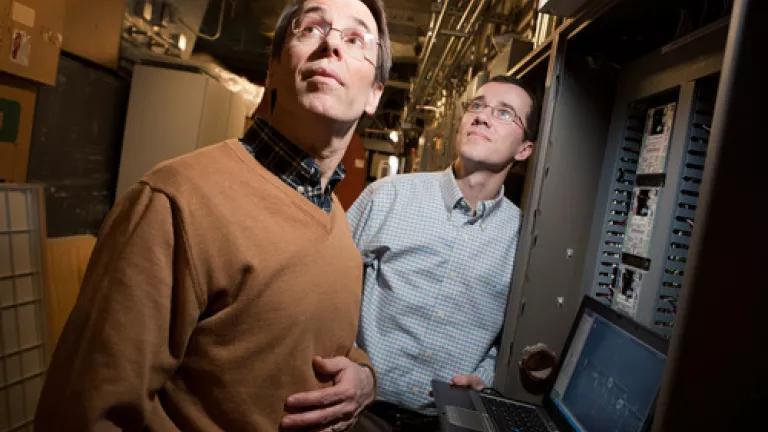
As the mother of a student at one of New York’s many great colleges, and of a high school junior who’ll apply to college in the fall, I have a connection to the issues that are on college students’ minds these days, issues that are much-discussed on college campuses. One of them is climate change and how to take effective action to reduce carbon pollution from college campuses.
That’s why last week’s announcement about energy efficiency measures at State University of New York campuses in 2013 is good news for just about everyone—not just college students and parents who have an eye towards our kids’ futures, but for all of us impacted by global warming and the extreme weather events we’re experiencing evermore frequently.
Cornell's Energy Management Director Lanny Joyce (left) and Senior Engineer Mark Howe survey energy upgrades at the Cornell Store that cut energy use by 40 percent.
In fact, New York state’s almost 200 public and private colleges and universities have been leaders in the field of energy efficiency, both among the state’s businesses and institutions and among institutions of higher learning nationwide. “I think NYSERDA [the New York State Energy Research & Development Authority] and the state in general in encouraging energy efficiency have helped make us pretty active,” says Lanny Joyce, director of energy management at Cornell University, in Ithaca. New York’s campuses, he says, have “invested real money in terms of getting stuff done.”
The SUNY announcements alone are pretty impressive: They’ll save the state university system an estimated $3.5 million a year and eliminate about 21,000 tons of greenhouse gases annually—the equivalent of taking almost 4,000 cars off the road. Among the projects undertaken are a new chiller at SUNY Purchase that uses ice thermal storage; HVAC and lighting upgrades at SUNY Brockport in Monroe County, near Rochester; and, new, energy-efficient window air conditioners at the SUNY Downstate Medical Campus in Brooklyn.

This new chiller at SUNY Purchase, and other energy efficiency upgrades, will help the SUNY system save $3.5 million on energy annually, with support from Gov. Cuomo's BuildSmartNY program.
These efficiency upgrades are funded through Governor Cuomo’s ambitious BuildSmartNY program, which seeks to cut energy use in state buildings by 20 percent by 2020. Together, SUNY and the City University of New York, in New York City, are the largest energy users in the state’s portfolio, with taxpayers and tuition-payers sharing about $250 million in annual energy costs. Lloyd Kass, BuildSmartNY’s director, estimates that the two university systems can cut their annual energy use by 22 percent. (BuildSmartNY is administered by the New York Power Authority.) “Part of the governor’s vision,” Kass explains, is not just to cut greenhouse gases and reduce the amount of money taxpayers spend on energy but also to “model and document solutions that the private sector can put in place.”
New York’s public universities aren’t the only campuses, though, where important efficiency gains are being achieved, advanced and demonstrated.
Other New York examples include:
• A Syracuse University data center that uses 50 percent less energy than a typical one, built in partnership with tech giant IBM and NYSERDA;
• a LEED-Gold sports complex at Rensselaer Polytechnic Institute that performs 33 percent above the New York State Energy Conservation Construction Code;
• and a Clarkson University research project, now underway, to study the energy and water use behaviors of college students and develop interventions that can help them act to improve efficiency.
Through a variety of clean energy projects, Cornell University has cut its carbon footprint by 30 percent since 2007, with a plan to become carbon neutral by 2050, Joyce says. That’s due, in part, to a supportive university administration and a climate-activist student body. But not only that. “The return on our energy-efficiency investments is often better than the rate of return on our endowment,” Joyce says. “Our net-present-value analysis allows us to take advantage of the fact that we’re going to continue to be on this campus for a long time to come.”
Students benefit from these improvements, too. Energy savings on campus are one way that colleges can contribute to carbon-pollution solutions, and—significantly, for both students concerned about college-loan debt and parents like me—these energy upgrades can help keep down the skyrocketing cost of tuition. Then, there are the educational opportunities these efficiency investments provide. “Students are incredibly interested in this,” says BuildSmartNY’s Kass. “The director of energy management at SUNY Purchase told me that the other night, 300 students came to hear him talk about all the different efficiency measures the university had implemented there.”
With NYSERDA’s help, New York state’s colleges and universities have become national leaders in energy efficiency. That’s a bright light on the horizon for students, parents, and taxpayers across the Empire State, as we all become more educated about the growing impacts of climate change and the key role of energy efficiency and clean energy in cutting carbon pollution and building the clean energy economy.

